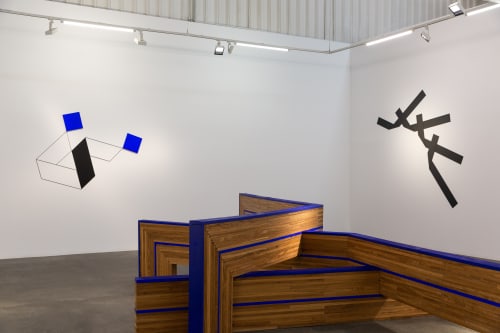Cardinal Points - the first solo exhibition of French-Iraqi artist Mehdi Moutashar (b. 1943, Iraq) at the gallery - presents a body of contemporary artworks that is quintessential to his practice, celebrating Moutashar as a meeting point between Islamic tradition and experimental optical art.
The exhibition’s centrepiece is Trois Angles à 135° (Three Angles at 135°) nicknamed by the artist as The Spider. This large-scale work constitutes numerous wooden blocks accented with blue, and produced by the intersection of three broken lines that spread outwards in six directions. The use of blocks and glimpses of blue reference the architectural traditions of Mesopotamia where mud bricks were highlighted in an ultramarine blue glaze. Moutashar does not think of his floor pieces as sculptures or installations but rather as constructions - constructed as they are of elements within a certain arrangement, in this case a mutable space of broken lines that appear to rotate.
This sense of rotation and dynamism is also apparent in Moutashar’s wall-based works. Using only black, white and ultramarine blue, these geometric sculpture-paintings give the illusion of an object in flux - either spinning or moving deliberately towards a target. In his black steel works, for example, each black rectangle is folded against itself and arranged as if to trace the points of a spiralling object.
In his other wall-based works Moutashar combines rectangles and squares made from steel, wood and elastic, endlessly configuring and reconfiguring them into energetic geometric compositions according to a set of rules of the artist’s devising. In all of these works he is equally concerned with the voids as with the solid parts, with light and with obscurity, leaving the viewer to create their own imagined outlines.
Moutashar’s working method and visual language reveal themselves in the titles of the works. Recurring words such plis (folds), mouvement (movement), angles and carrés (squares) appear in many of his titles. Though rarely explicitly calligraphic, his works also share certain traits with Arabic calligraphy. Moutashar’s squares recall the nuqta (dots) of the qalam (reed pen); his black rectangles and lines fold in on themselves, attenuating like calligraphic flourishes; his rule-based approach recalling those laid down by Ibn Muqla, Arab Vizer and calligraphers in the 10th century.
Alongside these are a group of works entitled Mouvement (2016) in which Moutashar remakes his lost geometric paintings from the late 1960s. Rather than using paper or canvas, his choice of laser-cut steel, painted either blue or black, allows for very different optical effects.
Mehdi Moutashar’s work inhabits a world of angles, folds and in-between spaces; an elusive universe that occupies the space between Iraq, his home of origin, and France, his home of choice.

